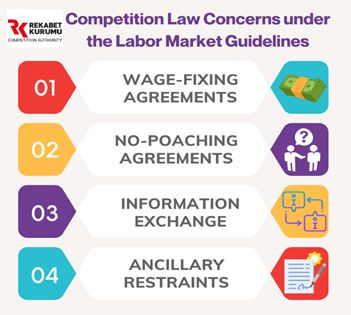- within Antitrust/Competition Law topic(s)
- in European Union
- in European Union
- within Energy and Natural Resources, Tax and International Law topic(s)
- with readers working within the Media & Information and Oil & Gas industries
Overview of the Labor Market Guidelines
The Turkish Competition Authority ("TCA") published the long-awaited Guidelines on Competition Infringements in Labor Markets ("Guidelines")1 on December 3, 2024, following the public consultation. The Guidelines aim to provide legal certainty and predictability within the scope of the Turkish Competition Act ("Competition Act") related to labor markets. As in many jurisdictions, in Türkiye, competition law violations in labor markets have become a significant focus for the TCA. Given the TCA's heightened scrutiny through investigations in recent years, including an ongoing one into the pharmaceutical sector, there has been a growing need for guidance and clarity specified to labor markets. In this context, the Guidelines are intended to establish the basic principles for identifying competition violations in labor markets and to highlight the importance of safeguarding a competitive environment for labor supply and demand in Türkiye.
The Guidelines state that in competitive labor markets, undertakings are expected to offer attractive wages and conditions, while employees choose jobs that match their skills and expectations. However, the structural characteristics of these markets can impede effective competition. Unlike traditional markets, labor markets typically have many employees on the supply side, but relatively few employers on the demand side which can lead to employers engaging in anti-competitive agreements or practices that limit the mobility of employees and the competition for wages and other working conditions. The Guidelines emphasize that the structural characteristics of the labor markets cause an imbalance of bargaining power between employers and employees, often favoring employers, particularly evident in industries with high levels of concentration. Moreover, employees are often reluctant to react to changes in wages and working conditions due to financial and social burdens associated with changing jobs. Consequently, they tend to endure unfavorable circumstances which reduces job mobility. Legal constraints such as non-compete agreements also further restrict their movement.
As per the Guidelines, undertakings' anticompetitive behaviors with respect to employee mobility, wages and other working conditions exacerbate the imbalance that already exists in labor markets which also affect the output markets by reducing the quality and efficiency of labor. Inefficient labor allocation hinders innovation and technological advancement as businesses fail to access suitable talent leading to fewer, lower-quality goods and services at higher prices for consumers. Furthermore, anti-competitive agreements in labor markets can reduce strategic uncertainty among firms with similar costs, encouraging coordinated behavior, particularly in markets where labor constitutes a significant portion of expenses, potentially leading to higher prices and consumer harm.
Competition Violations in Labor Markets under the Competition Act
The Guidelines stipulate that agreements or concerted practices between employers that have the object or effect of fixing the wages and other working conditions of employees, and such decisions and practices of associations of undertakings are considered violations of Article 4 of the Competition Act. In this respect, employers are not required to be competitors in output markets. Undertakings competing in the labor market are considered competitors independently of their activities in output markets.
While there may be various types of agreements that restrict competition between undertakings, the Guidelines focus on two main types of violations in labor markets; namely (i) wage-fixing agreements and (ii) no-poach agreements, as well as considers information exchange of sensitive labor market data and ancillary restraints within the scope of competition infringement.

- Wage-fixing agreements: These are the agreements where undertakings jointly determine the working conditions of their employees, such as wages, wage increases, working hours, fringe benefits, compensation, leave entitlements, and non-competition obligations. The Guidelines state that agreements to fix wages and other terms and conditions of employment constitute infringement by object.
- No-poach agreements: These are the agreements where undertakings agree not to offer jobs to or hire employees, either directly or indirectly. They may not always involve a complete ban on hiring but can require approval from the other business or the employee's current employer. Such agreements can apply to both current and former employees, and their main purpose is to restrict employee mobility between competing firms. The Guidelines underscore that no-poaching agreements that constitute an infringement by object are considered as cartels in the same context as supplier or customer allocation agreements.
Exchange of Information
Within the scope of the Guidelines, information is defined as any data directly or indirectly related to the labor, and information exchange refers to the exchange of such data between undertakings which can occur unilaterally, as in disclosing individual data or bilaterally, through mutual data exchange. In the exchange of competitively sensitive data of the input market, anti-competitive objects or effects may also arise. Per the Guidelines, competitively sensitive information that could lead to these outcomes includes data on wages or other working conditions that clearly impact employees' job choices or overall labor mobility, such as wage increase rates, working hours, benefits, compensation and leave entitlements. On the other hand, without examining the effects, any agreement having the object to restrict competition will be considered as a competition infringement.
A key addition to the published Guidelines, absent from the draft version is the introduction of cumulative conditions for information exchange to ensure that it does not have the effect of restricting competition, thus which can be considered as a safe harbor for undertakings. The conditions to be fulfilled are listed below:
- Information exchange must be conducted by an independent third party.
- The data source or individual data content must not be identifiable.
- The exchanged information should be at least three months old.
- The information must include the data of at least ten participants.
- No single participant's data should represent more than 25% of the total dataset.

Ancillary Restraints
After providing the definition of ancillary restraints under the scope of competition law, the Guidelines set out another critical issue which was not included in the draft version. Restrictions on wage determination or no-poaching, which are not deemed ancillary restraints—defined as those directly related, necessary, and proportionate to the implementation and continuation of the primary agreement—are explicitly stated to be evaluated under wage-fixing or no-poaching agreements. The Guidelines make it clear that such ancillary restraints will be deemed as violation by object.
When assessing whether workforce-related restrictions in main agreements which are not anti-competitive by object or effect would qualify as ancillary restraints, it will be evaluated whether such restrictions are directly related, necessary, and proportionate to the main agreement.
- Direct Relevance: For a restriction to meet the condition of direct relevance, it must be integral to and subject to the implementation of the main agreement, such that it would not exist independently of that agreement. Hence, the ancillary restraint should be directly relevant to the object of the main agreement, supporting or facilitating its purpose. Merely introducing the ancillary restraint at the same time as the main agreement is insufficient; however, if other conditions are met, it may still be considered directly relevant even if introduced later.
- Necessity: This condition requires a restraint to be essential for the implementation or continuation of the main agreement based on objective criteria. If the agreement cannot proceed without the restriction or parties would not enter into agreement in the absence of the restraint, then the restraint can be regarded necessary. On the other hand, if the agreement can be implemented with less restrictive alternatives, or without the restraint, then the necessity condition will not be satisfied.
- Proportionality: For a restraint to be
considered proportionate, it must be shown that the intended
objective cannot be achieved by any other means that would restrict
competition less. Additionally, the scope of the restriction should
be limited to the objective of the main agreement, its geographical
scope, duration, and the parties involved. The Guidelines state
that the TCA will assess the proportionality criteria based on the
specific circumstances of the case. However, the Guidelines
emphasize that the proportionality condition will not be satisfied
if:
- The restriction's duration is not clearly defined or is beyond what is necessary to achieve the intended objectives.
- It applies to employees unrelated to the key roles of the main agreement, or it is unclear which employees are subject to the restriction.
- It exceeds the geographic area of the main agreement.
- It applies to all or more parties to the main agreement when restricting only a few would suffice.
Implementation of Other Provisions of the Competition Act
The Guidelines highlight that in principle, wage-fixing and no-poach agreements in labor markets, along with information exchanges aimed at restricting competition will not qualify for exemption under Article 5 of the Competition Act.
In relation to the assessment to be made under the abuse of dominance provision, the Guidelines point out that abuse of dominance in labor markets may occur in various forms. Therefore, competition violations involving abuse of dominance will be evaluated by considering all the specific circumstances and characteristics of the case.
In merger control transactions, several factors will be considered in the assessment of whether the transaction significantly reduces competition in the labor market; including but not limited to the parties' market shares in the relevant labor market and the market's concentration level, the similarity in the skillsets of employees employed by the parties, barriers to entry in the relevant product market, the level of organization among labor market participants, employee switching costs and the capacity expansion or investment opportunities of competitors. Potential competitive pressure, the likelihood of increased cooperation among competitors in the labor market, and whether the transaction constitutes a potential killer acquisition will also be examined.
Conclusion
The publication of the Guidelines is a pivotal step toward providing clarity and predictability regarding competition law violations in labor markets. In addition, the TCA's stance made it clear that heightened focus and stricter probes into the HR sector underscore the need for such guidance for firms to be aware of the potential infringements falling under the scope of competition law and to ensure compliance. Notably, including a cumulative condition set to create a safe harbor for information exchange, free from anti-competitive effects in the Guidelines, is a crucial point resolving certain ambiguities. However, providing greater clarity on behaviors that may constitute violations would have been more helpful in guiding firms if the Guidelines included more details, such as example scenarios and a Q&A style approach similar to the those in other TCA guidelines. Such an approach is considered instrumental in fostering a clearer understanding of competitive concerns among firms. The publication of the Guidelines is likely to keep labor market investigations on the agenda as a key priority for the TCA, and the forthcoming decisions in this area remain to be seen.
Footnote
1. Turkish Competition Authority, "The Guidelines on Competition Infringements in Labor Markets", 3.12.2024, https://www.rekabet.gov.tr/Dosya/is-gucu-piyasalarindaki-rekabet-ihlallerine-yonelik-klavuz-ingilizce-20241205105305297.pdf
The content of this article is intended to provide a general guide to the subject matter. Specialist advice should be sought about your specific circumstances.


